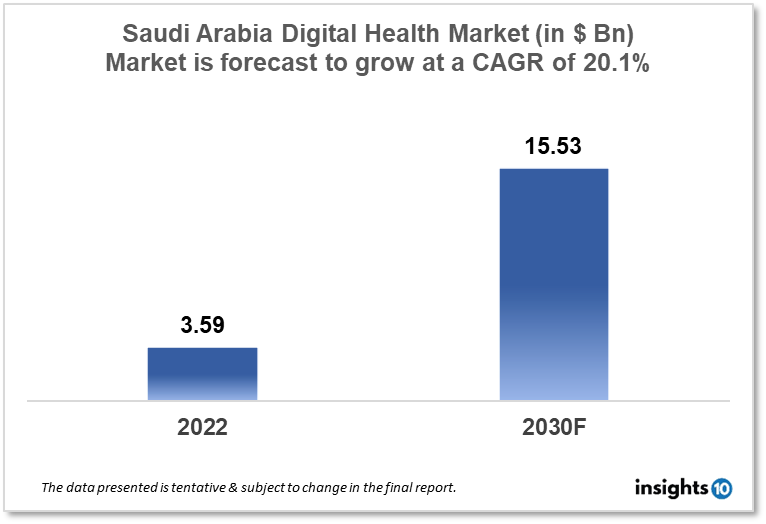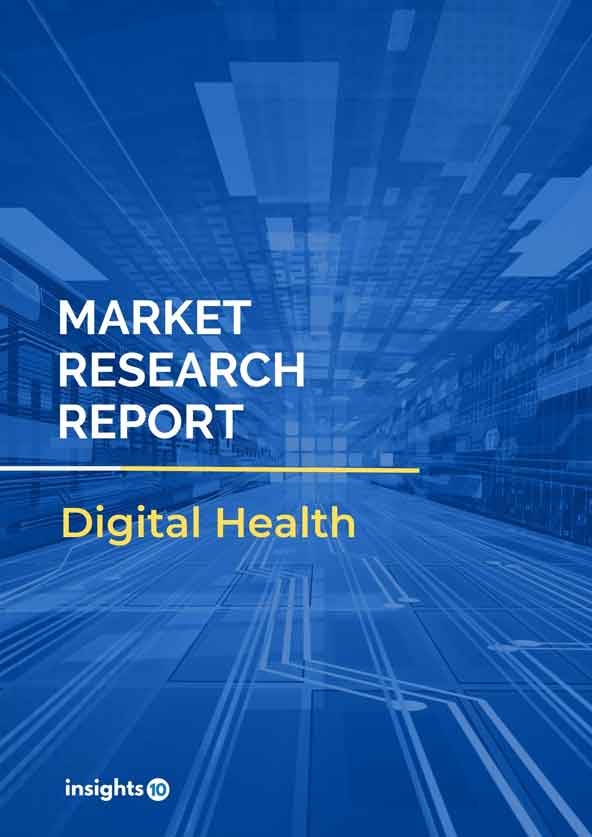Saudi Arabia Digital Health Market Analysis
Saudi Arabia's Digital Health market is projected to grow from $3.59Bn in 2022 to $15.53Bn by 2030, registering a CAGR of 20.1% during the forecast period of 2022-30. The market will be driven by government support and initiatives such as the "Vision 2030" plan & increasing demand for convenient and accessible healthcare. The market is segmented by solution, by deployment & by end-use. Some of the major players include Philips, GE Healthcare & Epic Systems.
Buy Now

Saudi Arabia Digital Health Market Executive Summary
Saudi Arabia's Digital Health market is projected to grow from $3.59Bn in 2022 to $15.53Bn by 2030, registering a CAGR of 20.1% during the forecast period of 2022-30. The healthcare expenditure (% of GDP) for Saudi Arabia declined from 5.75% in 2018 to 5.7% in 2019 according to the World Health Organization Global Health Expenditure database. In recent years, the Saudi government has pursued a number of measures to enhance healthcare in the country, including raising the healthcare budget and encouraging private sector participation in healthcare. Furthermore, Saudi Arabia is working on measures to save healthcare costs, such as deploying telemedicine and other digital health technologies to increase access to care, expanding the use of preventive care, and encouraging healthy lifestyle choices.
In Saudi Arabia, digital health uses technology to enhance patient outcomes and streamline healthcare delivery. The use of electronic medical records, telemedicine, mobile health applications, and other interactive platforms enhances the quality and performance of healthcare services. In accordance with the Vision 2030 framework, one of the key components of the healthcare plan is the introduction of electronic medical records (EMR) in all Saudi Arabian facilities. Saudi Arabia also launched the world's largest and Middle East's first virtual hospital “SEHA” in October 2022.

Market Dynamics
Market Growth Drivers
The National Digital Health Strategy intends to digitize all parts of the healthcare system, as well as the introduction of a national telemedicine program. Furthermore, the Saudi Food and Drug Authority (SFDA) is developing rules for the use of digital health goods and services in the Kingdom. Apart from government initiatives, the growing use of smartphones and other mobile devices in Saudi Arabia has made it simpler for people to use their mobile devices to access digital health services such as telemedicine. Furthermore, the aging population and the demand for cost-effective and appropriate healthcare solutions are driving the expansion of the country's digital health industry.
Market Restraints
The Saudi digital health industry may be hampered by problems such as poor digital literacy and awareness, a lack of laws and regulations data security and confidentiality concerns, resource limitations, the increased cost of digital health technologies, and a restricted approach by a health practitioner. These constraints may impede the expansion of the Saudi digital health market, but the government and commercial sectors are attempting to address them.
Competitive Landscape
Key Players
- Philips: A worldwide health technology leader that provides digital health solutions for telemedicine, imaging, and patient monitoring.
- Siemens Healthineers: A global provider of, medical imaging, and laboratory diagnostics offering digital health solutions
- GE Healthcare: A leading provider of medical imaging, health monitoring, and digital health solutions throughout the world
- Cerner: It is a major player in the digital health market, offering electronic health records (EHR) and other clinical information systems
- Epic Systems: is an EHR software firm that is involved in the Saudi digital health sector by supplying its EHR system to many of the country's leading institutions
Healthcare Policies and Regulatory Landscape
The Ministry of Health (MoH) oversees the digital health sector in conjunction with the Saudi Food and Drug Authority (SFDA), the Saudi Authority for Data and Artificial Intelligence (SDAIA), and the Communications and Information Technology Commission (CITC). The Kingdom of Saudi Arabia's Vision 2030 framework, which was adopted in 2017, authorized the promotion and guidance on the use of artificial intelligence (AI) and other data sources to promote new digital health solutions.
Health Sector Transformation Program launched in 2022 by the MoH, strives to ensure sustainable healthcare services in the Kingdom as well as a more effective and integrated health system with expanding provisions for telemedicine and e-health.
The National Platform for Health and Insurance Exchange Services (NPHIES) in collaboration with the Cooperative Health Insurance Council (CCHI), the National Health Information Center (NHIC), and the Ministry of Health launched a healthcare information exchange platform that aims to consolidate patient care data for healthcare providers and streamline insurance services.
Reimbursement Scenario
As part of its "Vision 2030" goal, the Saudi government is actively striving to build a reimbursement system for digital health services. However, at the moment, reimbursements for digital health services in Saudi Arabia are restricted, with patients bearing the majority of the cost. The government is working on developing the reimbursement system, although it is unclear when it will be completely operational. Furthermore, private insurance firms in Saudi Arabia have begun to offer coverage for digital health services, however, coverage remains limited and not widely available.
1. Executive Summary
1.1 Digital Health Overview
1.2 Global Scenario
1.3 Country Overview
1.4 Healthcare Scenario in Country
1.5 Digital Health Policy in Country
1.6 Recent Developments in the Country
2. Market Size and Forecasting
2.1 Market Size (With Excel and Methodology)
2.2 Market Segmentation (Check all Segments in Segmentation Section)
3. Market Dynamics
3.1 Market Drivers
3.2 Market Restraints
4. Competitive Landscape
4.1 Major Market Share
4.2 Key Company Profile (Check all Companies in the Summary Section)
4.2.1 Company
4.2.1.1 Overview
4.2.1.2 Product Applications and Services
4.2.1.3 Recent Developments
4.2.1.4 Partnerships Ecosystem
4.2.1.5 Financials (Based on Availability)
5. Reimbursement Scenario
5.1 Reimbursement Regulation
5.2 Reimbursement Process for Diagnosis
5.3 Reimbursement Process for Treatment
6. Methodology and Scope
Digital Health Market Segmentation
The Digital Health Market is segmented as mentioned below:
By Solution (Revenue, USD Billion):
- Software
- Services
By Deployment (Revenue, USD Billion):
- Cloud-based
- On-premises
By End-use (Revenue, USD Billion):
- Diagnostic Centres
- Healthcare Payers
- Healthcare Research Centres
- Hospitals & Clinics
- Nursing Care Centres
- Others
Insights10 will provide you with the reports within 10 key parameters which are:
- Market Overview
- Market Growth Drivers & Restraints
- Epidemiology of Disease Type
- Market Segmentation
- Market Share
- Competitive Landscape
- Key Company Profiles
- Healthcare Policies & Regulatory Framework
- Reimbursement Scenario
- Factors Driving Future Growth
Based on our many years of experience, we believe that these are the parameters that are critical to decision-making for business stakeholders. Our focused approach to developing reports focused on 10 key parameters, enabled us to arrive at the name “Insights10”.

Stage I: Market Data Collection
Primary Interviews: We have developed a network of experts, freelancers, and researchers across countries through which we engage with local experts to gather key data points and assumptions about each market. We also engage regularly with some of the best market research agencies such as Atheneum, GuidePoint, GLG, etc. to conduct surveys and interviews, and build intelligence. We have language translators as a part of our team, who between them can cover 30+ languages allowing us to extract better local insights.
Secondary Data Collection: We have developed strong expertise and experience in secondary data collection methods for developing unique data sets and research material. We gather data from multiple reliable sources to maintain a high level of accuracy and consistency. The market data is analyzed and forecasted using appropriate statistical and coherent models. The report offers an overall analysis of the market size, growth, and market share as well as a segment-level analysis of the specific market. Our report includes precise, to-the-point information related to the overall market, competition, growth drivers, challenges, regulatory updates, and competition.
Data Sources: We have access to multiple highly reliable free and subscription data sources. We have many years of experience to understand which sources are more dependable for what and which to prefer for the reliable and latest information. The key sources of information include the following, but are not limited to:

Stage II: Market Data Analysis and Statistical Model
Market Trends: We generally look at macro parameters and micro indicators. The macro parameters include changes in government policies, demand and supply of the market, government intervention programs, and major market share. The micro indicators are GDP growth, market size, market volume, etc. We also understand nuances specific to each country like the US, Canada, India, Germany, etc., and have worked across 60+ countries and hence not only understand global trends but how these differ by country, how payment models, market structure, cultural parameters, etc. differ in each country.
Market Sizing and Analysis: Our expert data analytics team has created various market forecast models by employing the top-down approach i.e. starting with the large overall market and segmenting different areas and the bottom-up approach i.e. starting with population and epidemiology and rolling up based on spend, etc., estimating the size of the market, and distributing among the geographic and/or product segments.
The top-down approach is mainly used for new product forecasting and the bottom-up approach is used for demand estimation of any product for different countries summed up to form the total market. We are able to round off insights and build stronger forecasts because we always do both these methods and triangulate the final numbers.
The study on the market covers the analysis of the leading geographies such as Asia-Pacific, Africa, Europe, Middle East, North America, and Latin America for the period of 2022 to 2030. The qualitative analysis covers the industry landscape and trends, market opportunities, competitive landscape, and policy and regulatory scenario, and the quantitative analysis covers different market estimates and forecasts.
Data Triangulation & Validation:
Data triangulation of various sources and results of the research are carried out by benchmarking with reliable sources such as industry statistics, statistical databases, and company-level averages, etc.
We make sure to finalize the numbers in alignment with the market research. Firstly, our internal experts ensure thorough validation and checking to ensure accurate and precise analysis and then validation is also done using a multiple-data analysis model. Two-level validation is done and entails the finalization of the report scope and the way of representation pattern.
(1).png)
Stage III: Interpretation and Presentation
Analysis & Interpretation: The information gathered is then analyzed and synthesized. The second series of interviews are done if necessary to check and validate. The future opportunities are analyzed by understanding product commercialization and many other factors. It also comprises the analysis of data discrepancies observed across various data sources. Information procured from secondary and primary results is then, interpreted by considering the following parameters: (a partial list)
- Establishing market drivers and trends
- Analyzing the regulatory landscape to understand future growth
- Market Segment based analysis to obtain revenue/volume
- Analyzing current needs and determining penetration to estimate the market
Insights: Our reports deliver actionable insights backed with supporting facts and figures to assist you in achieving exemplary growth. Our in-depth analyses are interspersed with relevant insights and statistics to offer an executive-level view of a given market. The description helps in correlating many minor factors affecting the market and their impact on the different segments within the market.
Data curated from the analysis and interpretation are drawn to portray all in one consolidated report.
Presentation & Reporting: The market research report is presented in different forms such as charts by using a scientific approach for easy understanding. Historic, current, and future analysis is provided for each market in terms of both value and volume. The size of the market is interpreted in the US Dollar value and the respective unit, based on the product, for volume consumption.
The foreign exchange rates are calculated on the respective dates and for the respective regions covered in the study.
To request a free sample copy of this report, please complete the form below.
We value your inquiry and offer free customization with every report to fulfil your exact research needs.
This report addresses
- Intelligent insights to take informed business decisions
- Qualitative, acute and result oriented market analysis
- Market size and forecasts from 2022 to 2030
- Opportunities for expansion and in-depth market analysis
- Segmentation and regional revenue forecasts
- Analysis of the market share and competitive landscape
- Strategic Recommendations to chart future course of action
- Comprehensive Market Research Report in PDF and PPT formats
Need more?
- Ask our analyst how this study was put together to learn more
- Discuss additional requirements as part of the free customisation
- Add more countries or regions to the scope
- Get answers to specific business questions
- Develop the business case to launch the product
- Find out how this report may influence your business revenue


